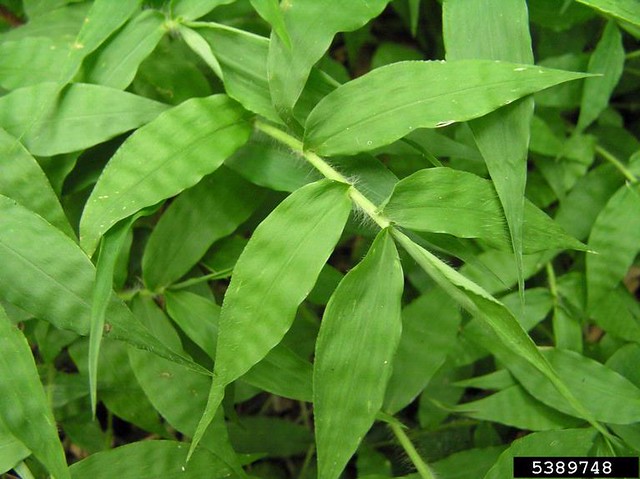Usually, when I’m looking for something (my car keys, for example), and I can’t find them anywhere, the first emotion that comes to mind is definitely not happiness.
So, when I and four other Department of Conservation and Recreation employees spent a very hot summer afternoon scouring over 16 miles of trails and did not find a single stem of the plant we were looking for, you might have expected to see some sad faces. However, in the search for Wavyleaf Basketgrass, this is just not the case.
 “Tired, hot, and happy wavyleaf basketgrass hunters.”
“Tired, hot, and happy wavyleaf basketgrass hunters.”
Photo left to right: Al Cire, Virginia State Parks; Tyler Meader, Danielle Kulas, and Kevin Heffernan, Division of Natural Heritage; and Katie Shepard, Virginia State Parks.
Wavyleaf basketgrass, wavyleaf grass for short, is an invasive grass that spreads rapidly in forests and meadows. It creates a thick carpet on the forest floor and crowds out native plant species. This plant was first identified in Maryland in 1996 and quickly spread along the Potomac River and through the Blue Ridge Mountains and into Shenandoah National Park.
 Wavyleaf basketgrass has a distinct wavy pattern on its leaves
Wavyleaf basketgrass has a distinct wavy pattern on its leaves
Photo Credit: Kerrie L. Kyde, Maryland Department of Natural Resources, Bugwood.org
Early detection is the key to stopping the spread of wavyleaf grass in Virginia State Parks. On June 24, 2014, a team of Virginia State Park and Division of Natural Heritage employees surveyed 16.4 miles of trails throughout Sky Meadows State Park in Delaplane, Va. No wavyleaf was found that day, but continued monitoring is important. This is where Virginia State Park Visitors come in! Here are some steps you can take to help stop this invasive plant:
-Stay on established trails: By staying on trails, we protect sensitive native species from being trampled on and avoid picking up the seeds of wavyleaf grass.
-Check yourself, pets, and horses for seeds: Wavyleaf grass blooms July through September. The seeds are very sticky and will “hitch a ride” on your clothes, shoes, and the fur of animals. Try to remove seeds onsite (sticky tape will sometimes help).
-Report sightings to park staff: Wavyleaf grass grows in full or dappled shade. There are several species that look similar to wavyleaf grass, including Japanese stilt-grass, Arthraxon, and native deer tongue; however, wavyleaf has some unique identifying characteristics:
-Distinctive wavy pattern on leaves
– ¼ inch hairs on stem, but NOT leaf edges
-Can be shin high, and looks a bit like bamboo
 Wavyleaf basketgrass
Wavyleaf basketgrass
Photo Credit: Garrett Waugaman, M-NCPPC Weed Warriors, Bugwood.org
Spotting wavyleaf grass early gives us the chance to remove the invasive species and protect the native plants present in our state parks. beautiful trails, we can stop wavyleaf grass before it becomes a problem.
For more information about wavyleaf basketgrass, you can click here.
